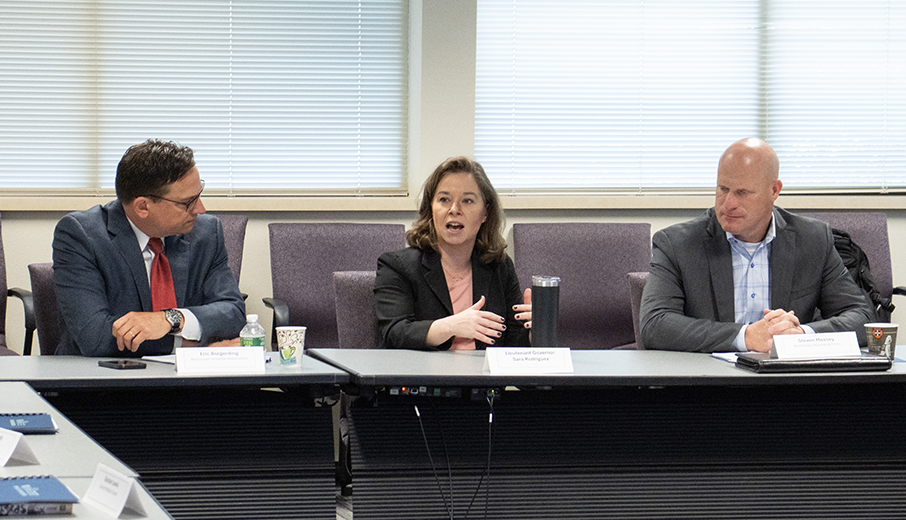Wisconsin’s Lieutenant Governor Sara Rodriguez joined WHA’s Public Policy Council on May 29 to discuss her role as the Chair of the Governor’s Task Force on Healthcare Workforce and the charges given to the Task Force as they work throughout the summer.
“As a clinician myself, I know how important it is that we shore up this industry’s workforce,” said Rodriguez. “It’s not just about registered nurses. It’s about all different types of roles, including technical roles that you all are struggling to fill.” Rodriguez cited data provided by WHA’s 2024 Health Care Workforce Report, showing that one of the largest vacancy rates – at 18% - was for licensed practical nurses but that vacancy rates for positions like surgical techs and radiology techs remain stubbornly high.
Rodriguez said that the Task Force is aiming to make recommendations to the Governor later this fall, which she expects to include proposals for funding in the state budget, regulatory reform and investments in broader support systems, like housing and childcare, for our healthcare workforce across the state. Rodriguez said that several WHA member hospitals have provided input to the Council. At the most recent meeting of the Task Force, the lieutenant governor hosted a panel that included WHA’s Senior Vice President Workforce & Clinical Practice Ann Zenk along with Emplify Health's Gundersen Region President Heather Schimmers.
“One of the areas that we have discussed regarding capacity for nursing schools is looking at who can be a clinical instructor,” proposed Rodriguez. “Other states have looked at one education level above, so if you are teaching at a bachelor’s level then instructors can be master’s prepared. If you are teaching at an ADN level, then instructors can be bachelor’s prepared. Other states have implemented something like that.”
The lieutenant governor gave credit to Wisconsin hospitals and health systems that are providing innovative solutions to workforce training, education and supply challenges. Rodriguez recognized Wisconsin’s ground-breaking first-in-the-nation registered nurse apprenticeship model and a growing number of health care apprenticeships being adopted in Wisconsin hospitals and health systems. She noted that such programs have helped to remove barriers for working nurses to also become faculty and for students who want to advance in their career.
“What I would really encourage you to do is to register your apprenticeships with the state,” said Rodriguez. “If you meet the program’s requirements, you are already a step ahead. What I’m hearing from the federal government is that they are pushing the apprenticeship model in non-traditional areas, such as healthcare, to be prepared to receive federal funding if it were to become available.”
When asked about encouraging more young people to consider a career in health care, Rodriguez said that it is important to get to students earlier and earlier – even in middle school. Rodriguez encouraged hospitals and health systems to work with local HOSA (Health Occupation Students of America) groups to solicit interest in health care careers by younger students. Just last month, the Wisconsin Hospital Association Foundation approved a matching grant opportunity for hospitals to help create HOSA chapters in their local communities.
“How does a high school student know that a surgical tech exists? They’ve seen a nurse, or had physical therapy and they’ve seen their physician – but how would they know that a surgical tech exists? Being able to show folks what types of roles exist within hospitals earlier on is going to be very valuable.”
In early 2024, WHA Foundation launched a health care career exploration website and statewide digital campaign called “So Many Options.” The campaign showcases the abundant health care career options, specifically appealing to a young audience (middle and high school students) and their adult influencers (parents, teachers, guidance counselors) to spark interest in pursuing a career in health care.
In soliciting additional priorities for the task force, Rodriguez heard from WHA President and CEO Eric Borgerding as he discussed the need to better utilize the workforce that Wisconsin already has by removing tasks that take providers away from the bedside.
“The amount of administrative burden that clinicians, care providers, are dealing with has exploded since the pandemic,” said Borgerding. “I’m not even talking about government burden, I’m talking about payer burdens. Study after study is showing the number of providers who are spending 13 to 19 hours per week just to get the permission to deliver the care that they know is needed.”
“That is something that we can look at more broadly as well,” said Rodriguez.  Lt. Gov. Sara Rodriguez, pictured with WHA President and CEO Eric Borgerding and Council Chair Steve Massey, speaks at WHA’s Council on Public Policy on May 29, 2024.
Lt. Gov. Sara Rodriguez, pictured with WHA President and CEO Eric Borgerding and Council Chair Steve Massey, speaks at WHA’s Council on Public Policy on May 29, 2024.